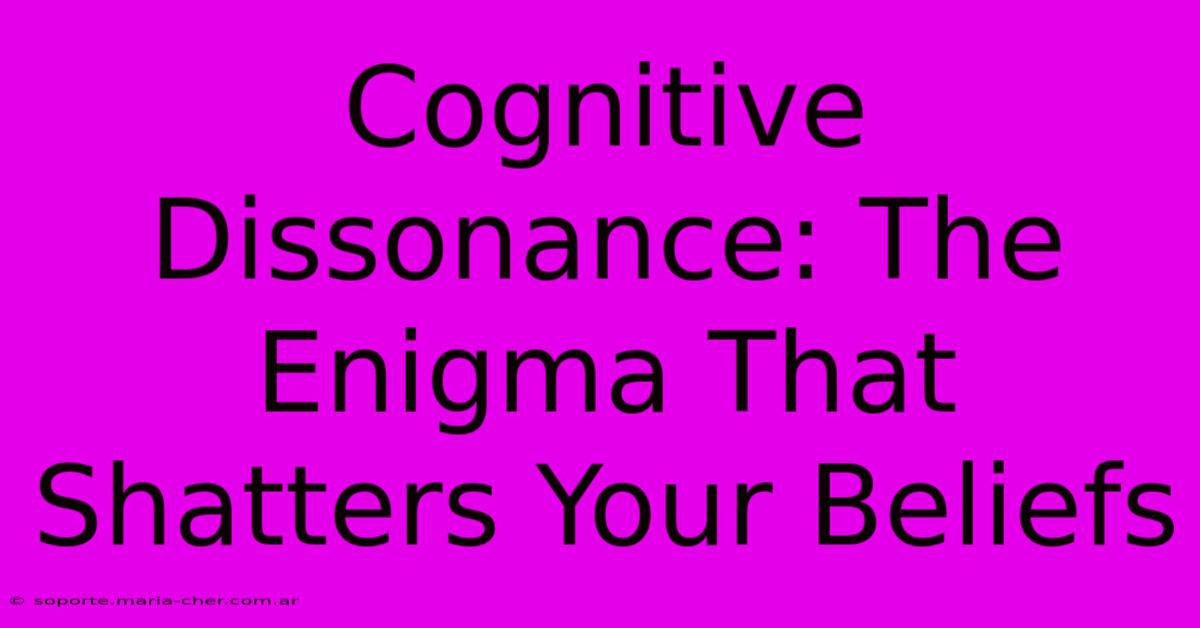Cognitive Dissonance: The Enigma That Shatters Your Beliefs

Table of Contents
Cognitive Dissonance: The Enigma That Shatters Your Beliefs
Cognitive dissonance. The term itself sounds a bit academic, even intimidating. But understanding this fascinating psychological phenomenon is key to understanding ourselves, our decisions, and the behaviors of those around us. It's the uncomfortable tension we feel when our beliefs clash with our actions, or when we hold two conflicting beliefs simultaneously. This article will delve into the intricacies of cognitive dissonance, exploring its causes, effects, and how to navigate its often-turbulent waters.
Understanding the Core Concept
At its heart, cognitive dissonance is a state of mental discomfort. It's that unsettling feeling you get when you realize you've done something that contradicts your values, or when you hold two opposing ideas in your mind. Our brains, naturally striving for consistency and internal harmony, actively work to reduce this discomfort. This reduction can manifest in various ways, some healthy, some less so.
Key Triggers of Cognitive Dissonance:
-
Decision-Making: After making a significant decision, we often experience dissonance. Did we choose the right option? We subconsciously justify our choice, even if it means downplaying the positives of the unchosen alternative. This is particularly true for significant purchases or career changes.
-
Effort Justification: The harder we work for something, the more likely we are to value it, even if it turns out to be less worthwhile than anticipated. Think about rigorous hazing rituals for joining exclusive groups – the pain endured justifies the perceived value of membership.
-
Moral Conflicts: Acting against our moral compass creates powerful dissonance. We may rationalize our actions, minimize their impact, or even change our beliefs to align with our behavior. This is a particularly dangerous aspect of cognitive dissonance.
-
Exposure to Disconfirming Evidence: When confronted with facts that contradict our deeply held beliefs, we often experience dissonance. Instead of changing our beliefs, we might dismiss the evidence, seek out confirming information, or even attack the source of the conflicting information.
The Mechanisms of Dissonance Reduction:
Our minds employ several strategies to alleviate the discomfort of cognitive dissonance:
-
Changing our beliefs: This is the most direct approach. We might re-evaluate our values or adjust our opinions to align with our actions.
-
Changing our behavior: We can alter our actions to match our beliefs. This is often the healthiest way to resolve dissonance.
-
Adding new cognitions: We might justify our actions or beliefs by adding new information or perspectives that reduce the conflict. This can lead to rationalization and denial.
-
Minimizing the importance of the conflict: We might downplay the significance of the conflicting beliefs or actions, thereby reducing their impact.
The Impact of Cognitive Dissonance:
Cognitive dissonance is not always negative. It can be a powerful motivator for personal growth and positive change. However, unchecked dissonance can lead to:
-
Poor decision-making: The need to reduce dissonance can cloud judgment and lead to irrational choices.
-
Confirmation bias: We actively seek out information that confirms our existing beliefs, while ignoring or dismissing contradictory evidence.
-
Increased stress and anxiety: The constant mental struggle to maintain consistency can be emotionally exhausting.
-
Resistance to change: The discomfort of dissonance can make us resistant to new ideas and perspectives.
Navigating the Labyrinth: Tips for Managing Cognitive Dissonance:
-
Self-awareness: Recognize when you are experiencing dissonance. This is the crucial first step.
-
Open-mindedness: Be willing to consider alternative perspectives and challenge your own beliefs.
-
Honest self-reflection: Examine your actions and beliefs objectively, without judgment.
-
Acceptance of discomfort: Allow yourself to feel the discomfort of dissonance; it's a sign that you are growing and learning.
-
Seek diverse viewpoints: Engage with people who hold different perspectives to broaden your understanding.
Cognitive dissonance is an intricate part of the human experience. Understanding this phenomenon allows us to better understand our own behavior and the behavior of others. By learning to navigate the complexities of cognitive dissonance, we can make more informed decisions, foster personal growth, and cultivate more meaningful relationships.

Thank you for visiting our website wich cover about Cognitive Dissonance: The Enigma That Shatters Your Beliefs. We hope the information provided has been useful to you. Feel free to contact us if you have any questions or need further assistance. See you next time and dont miss to bookmark.
Featured Posts
-
Peek Into The Past With Visconti Sforza A Historical Journey Through Tarot
Feb 07, 2025
-
Unlock The Secrets Of Streaming Apps The Ultimate Guide For Educators
Feb 07, 2025
-
Maximize Your Seasons Impact Corporate Cards With A Touch Of Brilliance
Feb 07, 2025
-
Elevate Your Ear Style The Modern Guide To Second Hole Piercing Excellence
Feb 07, 2025
-
Needling The Truth Sewed Or Sowed The Mystery Unveiled
Feb 07, 2025
